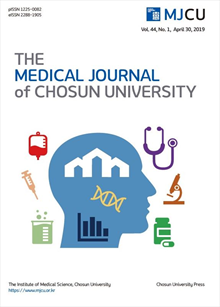간행물
The Medical Journal of Chosun University 조선대학교 의대논문집

- 발행기관 조선대학교 의학연구원
- 자료유형 학술지
- 간기 반년간
- ISSN 1225-0082 (Print)2288-1905 (Online)
- 수록기간 2013 ~ 2019
- 주제분류 의약학 > 의학일반 의약학 분류의 다른 간행물
- 십진분류KDC 510DDC 610
권호리스트/논문검색
Vol. 42 No. 3 (2017년 9월) 4건
1.
2017.09
서비스 종료(열람 제한)
This manuscript is reporting the usefulness and treatment results of internal fixation with PHILOS plate in proximal humerus fractures with osteoporosis. Sixteen cases of proximal humerus fractures with osteoporosis were surgically treated with PHILOS plate and followed up for an average 11 months (8-23 months). Mean age was 63 years old (range, 47-88 years old). The functional results were assessed by Neer’s evaluation criteria, Constant evaluation criteria and Korea shoulder scoring system. And the radiological results were assessed by Paavolainen’s method. The mean BMD T- score is -3.5, the mean bone union periods were 15.9 weeks. Functional satisfactory results were thirteen cases in Neer’s evaluation criteria, good results were fourteen cases in Constant evaluation criteria and the mean score is eighty-nine points in Korea shoulder scoring system. Radiologic good results were noted in thirteen cases and fair results were noted in one case. One case showed screw loosening in complication. Internal fixation using PHILOS plate for proximal humerus fractures with osteoporosis makes good functional and radiologic results, so that is considered as a good method.
2.
2017.09
서비스 종료(열람 제한)
Primary sarcoma of the breast is extremely rare and it is a diagnosis of exclusion, notably metaplastic carcinomas and malig-nant phyllodes tumors. We present a case of 53-year old Korean female with undifferentiated pleomorphic sarcoma with CD10 expression. It was a high grade tumor composed of spindle cells, and immunohistochemical analysis revealed negati- vity for cytokeratins and CD34, but focal positivity for actin, diffuse positivity for CD10 and vimentin. These results led to the diagnosis of undifferentiated pleomorphic sarcoma. This case represents a rare variant of primary breast sarcoma which imposes a diagnostic difficulty, and highlights the importance of CD10 expression.
3.
2017.09
서비스 종료(열람 제한)
Jin Wan An, Young Min Jo, Seung Hyun Lee, Chul Hwan So, Du Young Choi, Chang Woo Lee, Yeon Kyun Oh, Seung Taek Yu
This study aimed to analyze difference in clinical findings, including coronary artery complications, in patients with Kawasaki disease and respiratory symptoms with several respiratory infections. We studied 182 pediatric patients diagnosed with Kawasaki disease. Examinations for respiratory viral polymerase chain reaction were conducted in the group of patients with respiratory symptoms. Echocardiography was perfomed by a pediatric cardiologist, and laboratory findings were evaluated. Clinical manifestations and laboratory findings based on medical records were compared. There were no differences between patients with and without respiratory viral infections with respect to age, male-female ratio, coronary artery complications, Kawasaki disease-specific clinical manifestations, duration of fever, duration of hospitalization, or recurrence rate. There was a significant difference in C-reactive protein levels (55.6 vs. 73.9 mg/L) between the two groups, but the other laboratory findings. The rate of respiratory infections in pediatric patients with Kawasaki disease was similar to those reported in previous studies, and clinical manifestations and laboratory findings were not significantly different between the groups.
4.
2017.09
서비스 종료(열람 제한)
Surgery for thyroid disease is becoming much more common, but in some specialized institutions, ENT surgeons have difficulty obtaining experience of parathyroid surgery. Parathyroid disease can be divided into parathyroid adenoma with hyperparathyroidism and secondary hyperparathyroidism due to chronic kidney disease. Parathyroid adenoma with hyperparathyroidism is the most common cause of hypercalcemia and usually presents as nonspecific symptoms, such as, general weakness, osteoporosis, gastrointestinal disorder, kidney stones, and/or neurological symptoms, and thus, diagnosis is often delayed. Patients with secondary hyperparathyroidism due to chronic kidney disease require parathyroidectomy 10 years after the onset of dialysis in 6-10% of cases even when continuously treated in a nephrology department. Here, the authors share their experiences of parathyroid surgery.

